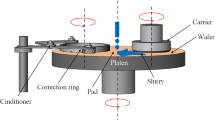Abstract
With magnetic heads operating closer to hard disks, the hard disks must be ultra-smooth. The abrasive-free polishing (AFP) performance of cumene hydroperoxide (CHP) as the initiator in H2O2-based slurry for hard disk substrate was investigated in our work, and the results showed that the slurry including CHP could improve the material removal rate (MRR) and also reduce surface roughness. Electron spin-resonance spectroscopy (EPR), electrochemical measurement and Auger electron spectroscopy (AES) were conducted to investigate the acting mechanism with CHP during the polishing process. Compared with the H2O2 slurry, the EPR analysis shows that the CHP–H2O2 slurry provides a higher concentration of the HOO free radical. In addition, the AES analysis shows the oxidization reaction occurs in the external layer of the substrate surface. Furthermore, electrochemical measurements reveal that CHP can promote the electrochemical effect in AFP and lead to the increase of MRR.
Similar content being viewed by others
References
S.T.S. Bukkapatnam, P.K. Rao, W.C. Lih, N. Chandrasekaran, and R. Komanduri, J. Appl. Physiol. A88, 785 (2007).
W. Zhang, X.C. Lu, Y.H. Liu, G.S. Pan, and J.B. Luo, J. Electrochem. Soc. 156, 176 (2009).
H. Lei and J.B. Luo, Wear 257, 461 (2004).
Z.Q. Qi and W.M. Lee, Tribol. Int. 43, 810 (2010).
S. Kondo, N. Sakuma, Y. Homma, Y. Goto, N. Ohashi, H. Yamaguchi, and N. Owada, J. Electrochem. Soc. 147, 3907 (2000).
T. Okamoto, Y. Sano, K. Tachibana, and B. Van Pho, Jpn. J. Appl. Physiol. 51, 046501 (2012).
W. Zhang, X.C. Lu, Y.H. Liu, G.S. Pan, and J.B. Luo, Appl. Surf. Sci. 255, 4114 (2009).
W.T. Zhang and H. Lei, Adv. Mater. Res. 690, 3209 (2013).
S.S. Chen, H. Lei, and R.L. Chen, Key Eng. Mater. 562, 691 (2013).
R. Zhao and H. Lei, Adv. Mater. Res. 690, 3222 (2013).
Z.J. Wang and H. Lei, Key Eng. Mater. 562, 91 (2013).
M. Harlharaputhiran, J. Zhang, S. Ramarajan, J.J. Keleher, Y. Li, and S.V. Babu, J. Electrochem. Soc. 147, 3820 (2000).
H. Li, H. Lei, and R.L. Chen, Thin Solid Films 520, 6174 (2012).
H.J. Liang, Tribol. Int. 38, 235–242 (2005).
H. Lei, Chin. J. Inorg. Chem. 25, 206 (2009).
G. Lim, J.H. Lee, and J. Kim, et al., Wear 257, 863 (2004).
Y. Seo, N. Kim, and W. Lee, J. Mater. Lett. 60, 1192 (2006).
Y.J. Seo, Microelectron. Eng. 84, 2769 (2007).
Acknowledgements
This work was supported by National Natural Science Foundation of China (Grant No. 51175317), Research Fund for the Docoral Program of Higher Education of China (Grant No. 20123108110016), Innovation Program of Shanghai Municipal Education Commission (No. 13YZ004), Tribology Science Fund of State Key Laboratory of Tribology (No. SKLTKF11B06).
Author information
Authors and Affiliations
Corresponding author
Rights and permissions
About this article
Cite this article
Jiang, T., Lei, H. Abrasive-Free Chemical Mechanical Polishing of Hard Disk Substrate with Cumene Hydroperoxide-H2O2 Slurry. J. Electron. Mater. 43, 4186–4192 (2014). https://doi.org/10.1007/s11664-014-3303-2
Received:
Accepted:
Published:
Issue Date:
DOI: https://doi.org/10.1007/s11664-014-3303-2




